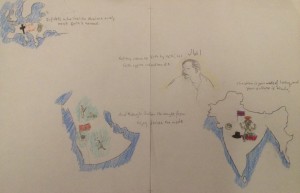Creative Response
Iqbal’s Spiritual Geography
For my creative response, I used geography as a lens to investigate Iqbal’s vision of Islam. I found that Iqbal often uses space to refer to different elements of the Muslim world, and to highlight both Islam’s weaknesses and the revival necessary for its strengthening. In my response, I have delineated three separate geographical spaces that Iqbal uses. The first is India, his native land. For Iqbal, everything wrong with contemporary Islamic belief and practice can be found within India. In effect, India is the poster child of Islamic power in despair. It is in India where we see all the transgressions and infidelity against a true Islam that Iqbal idealizes. Within the framework of India, we see how Iqbal isolates two major faults within the Muslim community: the import of indigenous religious customs and the rise of western secular culture. Iqbal sums this up as he writes in reference to India, “Christian is your mode of living, and your culture is Hindu.” I included this verse on my response because I thought it perfectly captured Iqbal’s attitude towards India, as a place where Muslim practice is tainted with indigenous customs that are contrary to proper Islam, and where many seek to model their culture off of the West. I tried to reinforce this idea with several symbols representing Iqbal’s view of India. There is the British flag, to represent western political dominance, a tea-cup and top hat symbolizing western culture’s influence on Indian society, and a statue of Ganesha to represent Iqbal’s view of Islamic practice being tainted by Hindu idolatry.
Far in the left-hand corner I placed the continent of Europe. I wanted it to stay out of the center of the image, as its cultural role in Iqbal’s poem is more tangential. Politically, Europe is both the enemy, but also a model of sorts. It is clear that, while Iqbal views Europe adversarialy, he recognized a level of cultural and religious consciousness there that he would like to see return to India. I was somewhat influenced by the quote from Muhammad Abduh, in which he laments that “I went to the West and saw Islam, but no Muslims; I got back to the East and saw Muslims, but not Islam.” I believe that Iqbal maintains this idea that the central idea of islam, of submission to God, is more present in Europe, and indeed is the reason why the West was able to rise to such political power. This is what he means when he writes of the “infidels who live like Muslims.” Thus I placed mostly religious symbols in Europe, including a cross and a crucifix, as well as the phrase “God is Great,” which I specifically took from Islam. Conversely, while India and elsewhere was Muslim, submission to God was lacking in the Islamic world, accounting for the loss of Muslim political power. This faith based approach to political power is central to Iqbal’s entire premise, which is why I placed the verse “nations come to birth by faith; let faith expire, and nations die” right above Iqbal himself. For me, this is the guiding premise with which Iqbal approaches his subject. Additionally, this idea contributes to my chosen them of geography. In my response, I use this central idea to tether different part of the world with different levels of both religious and political development.
Arabia presents the most complex region in Iqbal’s work. While Iqbal certainly laments the waning of Ottoman power, whose control over Arabia is represented by their flag, Iqbal mostly glosses over contemporary history when approaching the “birthplace of Islam.” Arabia is much more present in Iqbal as a romanticized Islamic ideal. For Iqbal, the oath to Muslim revival is through an adoption of Arab ways of life. For Muslims to truly follow Islam, they must “return” to the customs and religious practice of the Arabian peninsula. For Iqbal, Islam cannot be taken out of an Arab context. Even though his main object is India, Iqbal sees Arab culture as the model; he writes that “though Indian the song be, from Hejaz derives the mode.” Iqbal’s poetry is filled with references to Arabia, to Hejaz and Nejd. It is for this reason that I outlined much of Arabia in green, the color associated with Islam. I furthermore included the figure of Qais. As an Arab figure, Qais’s search for Layla, and thus for God, within himself further pushes Iqbal’s conception of Arabia as the epitome of Islam. To drive home this idea, I included the Kaaba and a man praying as two more symbols for the Islamic purity that Iqbal advocates.
In the middle of these three regions I have included the portrait of Iqbal himself. I placed him just above India, to plant him firmly in his native land, however his positioning and gaze clearly show a viewpoint towards the other regions I’ve depicted. Rather than looking inwards within India for answers, Iqbal looks elsewhere—to Europe and the Arab world. Iqbal’s position within the drawing solidifies my interpretation of Iqbal as a thinker looking outward and using geography as a framework for philosophy.
